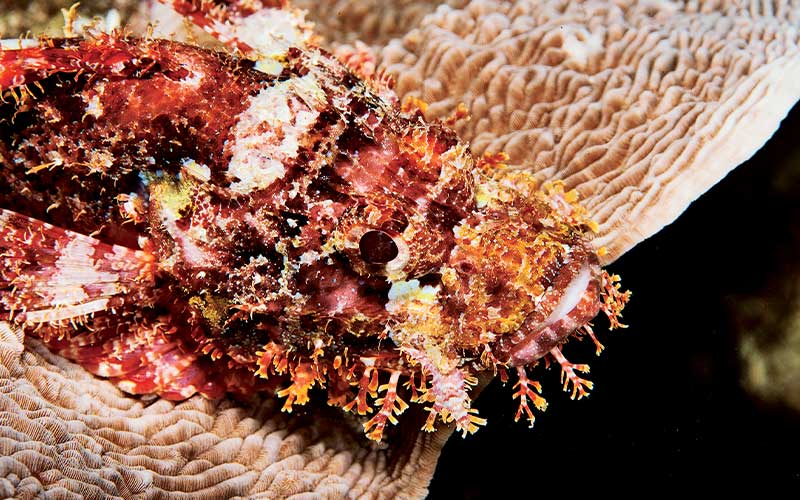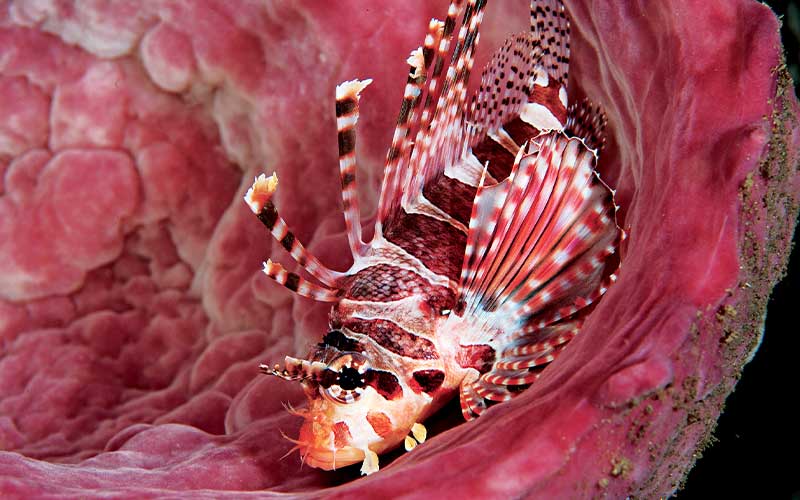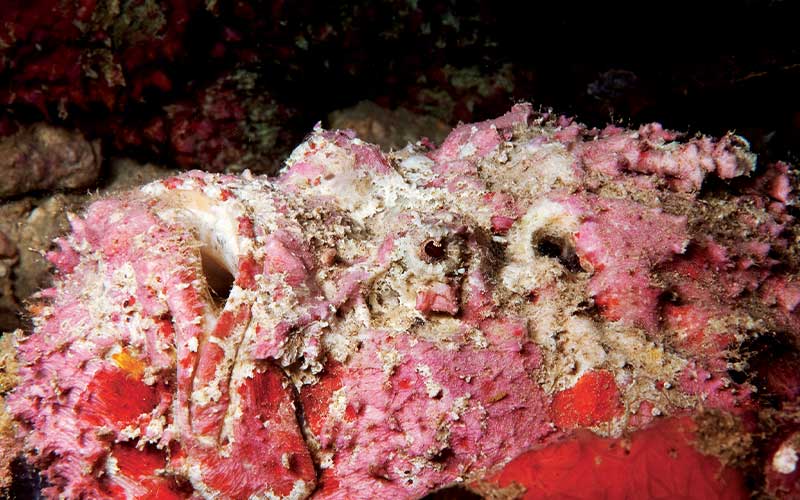Many marine vertebrates are equipped with toxin-based defense systems. While caution, a healthy respect and distance are usually adequate protection from these creatures, accidents happen, leaving some divers envenomed with potentially serious medical effects. Knowing how to provide first aid in these situations can hasten recovery and prevent complications.
Envenomations: General Treatment Principles
For the most part, marine vertebrate venoms are comprised of many bioactive chemicals, including one or more proteins. Toxic effects, such as pain, manifest through destruction of local tissue and/or irritation or disruption of a person’s peripheral nervous system. In general, treatment goals are to remove as much of the active venom as possible and to reduce the effects of the toxins. Pain is best reduced by irrigating the affected area with hot water (“to tolerance” to avoid thermal burns). In addition to pain reduction, it also serves as the first step (followed by scrubbing and extracting spines) in removing the venom and potentially infectious organic foreign material.
Symptoms may result from the direct toxic effects of the venom. In addition, venom may cause an allergic reaction in a manner similar to that from bee stings. The reaction for some persons may be only pain and swelling, while others may experience potentially dangerous respiratory distress. Most allergic reactions involve only skin symptoms such as swelling, rash and itchiness. Reactions severe enough to cause breathing distress are rare; however, when they occur, first aid support may include injectable epinephrine (adrenalin), provision of inhaled oxygen, an antihistamine such as diphenhydramine (Benadryl), and a steroid such as prednisone. Regardless of what first aid is administered, any patient with a serious allergic reaction should be treated by a physician as soon as possible.

Stingray Envenomation
Stingrays are beautiful and graceful creatures, but their tails carry barbed spines with two ventrolateral venom-containing grooves. When provoked, the stingray thrusts its tail into the victim, producing a deep, jagged laceration. Removal of the spine is often dangerous because the sharp barbs produce significant tissue damage; potentially serious hemorrhage may occur when extraction is attempted. Attacks usually occur to the foot or lower leg, as “attacks” are often the result of stingrays semi-buried in sediment or sand being stepped on unexpectedly. Stingray spines impaled deeply in any tissue (in particular the abdomen or chest) should be removed only in a controlled medical environment such as an emergency room.
Stingray envenomation usually causes significant pain, but it is rarely fatal. Effects include local tissue damage as well as neurologic and musculoskeletal symptoms. Immediate treatment should focus on washing the wound vigorously with clean, fresh water. Immerse the wound in water as hot as can be tolerated (approximately 110°F); this sometimes provides pain relief for up to 90 minutes. Remove as much of the spine(s) and foreign material as possible, then scrub the wound with soap and irrigate again with heated fresh water. Wounds should be left open, unless packing and bandaging are necessary to reduce bleeding. If significant tissue damage has occurred, if damage to deep structures such as muscle or subcutaneous fat is suspected, or if the victim has an impaired immune system (e.g., diabetes, HIV, cancer or regular steroid use) administration of an antibiotic should be considered.
Scorpionfish Envenomation (Lionfish, Stonefish and Scorpionfish)

After stingrays, the scorpionfish family is responsible for more envenomations than all other marine vertebrates. This group includes lionfish, scorpionfish and stonefish. Lionfish have the smallest spines and least toxic venom, while scorpionfish have shorter, thicker spines and larger venom glands along with a more potent and toxic sting. Stonefish have significant spines that cause very toxic and potentially injurious envenomations. In general, severity of envenomation depends on a variety of factors, including the envenomation site, number of stings and underlying health of the person stung. Lionfish envenomations may cause significant pain but are rarely fatal. Scorpionfish and stonefish stings are generally felt to be more serious, although available literature on the subject suggests the number of deaths directly attributable to envenomations is likely much lower than commonly believed. Systemic symptoms such as nausea, vomiting and weakness are usually more common in scorpionfish and stonefish envenomations than in lionfish stings.
First aid for scorpionfish envenomations follows the same protocol as that for stingrays: Irrigate and immerse the affected area in hot water; remove foreign material and scrub the wound. Leave the wound open, and if the wound appears to become infected, administer antibiotics with activity against marine organisms.
Antivenin for stonefish stings is available in the South Pacific and Australia. While this therapy is helpful in the majority of cases when it is used, it should be administered only in a hospital setting because serious allergic reactions are possible.

Catfish and Weeverfish Stings
Catfish and weeverfish are two other types of fish capable of delivering significant envenomations. Catfish, species of which are found in both fresh and salt water, have dorsal and pectoral spines that may result in puncture wounds, particularly when the creatures are handled. The venom of most catfish is considered to be fairly mild, generating symptoms comparable to those of a bee sting.
Weeverfish are somewhat aggressive and some of the few fish that may attack divers without provocation. However, most stings occur when divers or swimmers step on the fish, which is typically buried in the sand awaiting prey. Weeverfish venom is toxic to nervous tissue, so symptoms are primarily neurologic in nature; itching, tingling and severe pain at the wound site are common. Systemic effects are less common but may be serious, involving respiratory difficulty and/or paralysis.
If treating a catfish or weeverfish sting, administer the same first aid treatment as for scorpionfish stings.
The best approach to all marine vertebrate envenomations is to avoid contact with a potentially toxic creature. In the event of an encounter, remember that most marine vertebrate envenomations involve significant local pain with tissue swelling and minor damage, which may respond to hot water immersion. If a victim seems more than minimally ill or if you are in doubt, seek immediate medical care to assist with treatment.
© Alert Diver — Q1 Winter 2011